What is PCT?
A simple start…
PCT stands for Perceptual Control Theory. Big words, eh?
The ‘big idea’ behind PCT is simple but don’t be surprised if it takes a while to get your head around.
This is it….
‘Behaviour is the control of perception’
That’s it.
Or more simply, we do things to get what we want – now that sounds too simple!
Let’s take it a step at a time…
PCT is a theory about ‘control’ in living things, like people, cats and fish. It’s about the control of what they perceive – what they notice, look at, feel, hear, taste and smell.
The living thing is in the driver’s seat. PCT is a theory from the person’s own point of view – or the animal’s own point of view…

In the driving seat…
When things are working normally, the person gets to experience what they want to experience. It is ‘just right’ – like the perfect cup of coffee or tea…

But how do they know this is happening?
According to PCT, the person compares a ‘standard’ – what they want – with what they are experiencing right now – their perception.
The difference between the two – the discrepancy or error is being measured.
The bigger the error the more the effort the person makes to reduce it, until the error is zero – this means they get what they want.
Imagine you are driving your car.
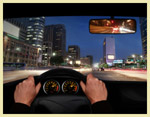
You see your target on your left – your office block. But you want it straight on.
So, you put effort into turning the wheel until you are looking straight at the store. If a dip in the road knocks you off course – a disturbance – you correct yourself again. For now, you have got what you want. You might want to read about research on driving as a process of maintaining ‘safety margins’, consistent with PCT (Nilsson, 2001).
This is just an explanation of the main idea of PCT. It’s not the fully story.
We get to do very complicated things, like eat pizza and run for president through PCT too, but this is a bit clearer when we cover a bit more.
The closed loop…
This system that corrects error to help us reach our goals can be shown in a diagram. It’s called a negative feedback loop or a closed loop.
Closed loops come up in lots of places – from the system in your body that helps to control its temperature – to the thermostat in your house. Even guided missiles use the same idea.

In PCT, closed loops are the only component of the theory – they form the fundamental structure of the way that the brain and nerves of a person work according to the theory.
Let’s have a look at a simple closed loop working for temperature control.
The reference value for the temperature is 37˚
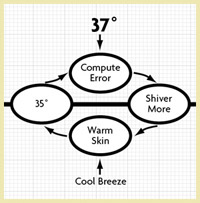
The input is the temperature – 35˚ in this case due to a cool breeze – the disturbance from the environment
The error is 2˚
This drives the output – in this case shivering more. The shivering warms the skin, getting the body temperature nearer 37˚
All the parts of this loop are working at once in the body, as are the loops controlling many other important variables we need to keep just right…
The closed loop in detail…
We have explained a simple loop for controlling temperature…
But how does PCT control experiences – perceptual variables?
The diagram below, taken from Bill Powers’ most recent book, shows the full details of a closed loop in PCT.
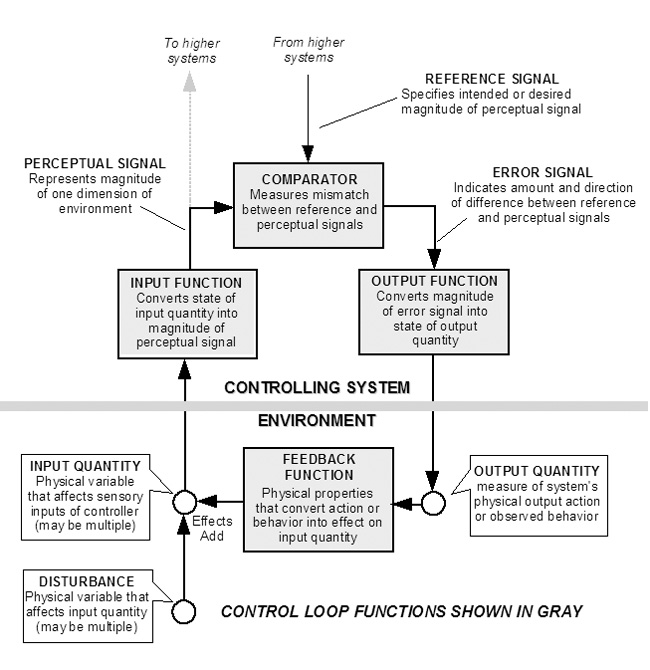
It’s essentially the same with a few more details… First, it shows what are signals and what are functions. The functions have mathematical formulas that change one signal, or a set of signals into a new signal.
Second, it shows that the environment can provide feedback to the person, not just a disturbance. One example of feedback is when you talk into an amplifier – it feeds back your output (voice)!

Here is another colourful example. Albino rats have poor vision with their pink eyes owing to low levels of melanin in the retina. So, to see properly they sway their head from side to side; this helps them to see in 3D as the image to each eye changes with the headsway – this behaviour is the control of their perception. Click here to see! In an academic article, Robert Patterson explains why a control theory approach is vital to understand 3D vision (steropsis) in all animals.
Third, this diagram illustrates that goals can operate without any requirement for ‘awareness’ or ‘consciousness’ in the system. This is consistent with emerging evidence from cognitive science, summarised here in a paper by Custers and Aarts (2010).
Fourth, and really important, is that this loop is at the bottom of many more loops – it sends information up to them and receives its information from them…
So what is going on here?
A hierarchy of control…
Earlier we noted that the closed loop is the only working ‘thing’ in PCT – it is the fundamental unit.
It is a bit like a house. Everything is made of bricks, and it is the arrangement of the bricks that makes it a house.

In PCT, closed loops make up the whole of the nervous system, but it is the way they are arranged that makes them work as they do – to manage very complex things.
In PCT the loops become organised in a hierarchy as the living thing develops.
At the lowest level, they control intensity of experience – like getting the just right amount of pressure to push a broken down car.

At the highest levels, the systems control experiences like a person’s idea of themselves, or their concept of loyalty.
When the loops are connected together, you can start to see how people can begin to control pretty complex things in their lives…
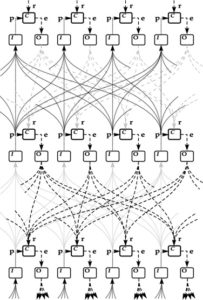
According to the theory, there are about eleven levels altogether. See this diagram by Fred Nickols. However the exact number isn’t that important… it’s how they connect together.
The concept of a hierarchy is found in many other psychological theories (e.g. see Stallings, 1974). However, PCT is exact about how the hierarchy is organised (e.g. Powers, 1998)
It’s all in the connections…
It’s really important to note how these many levels are connected.
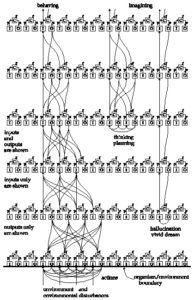
Remember – the only loops that control behaviour are the ones right at the bottom – the ones that sit next to the environment.
All of the loops above that just set the standards, or reference values, for the loops below. And they send out these signals constantly, fanning out down the array of loops below. To some of these loops the signals are weighted so they are affected strongly. Others are affected very little, and there are a whole range of weights in between…
At the same time as all these signals are going down, a whole raft of signals are going up too… so the loops at the top get to manage the experiences coming in that have not been brought into line by the lower loops.
When the lower loops are controlling really well, we get the sense that things are going on automatically – we might not even notice that we are ‘in control’.
The levels of PCT are clearly explained in the book Make Sense of Behavior (Powers, 1998).
* Images reproduced with permission from ‘People as Living Things’ by Philip Runkel, www.livingcontrolsystems.com.
